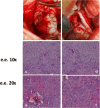Bilateral Central Giant Cell Granuloma of the mandibular angle in three females from the same family
- PMID: 30180903
- PMCID: PMC6122611
- DOI: 10.1186/s13005-018-0171-7
Bilateral Central Giant Cell Granuloma of the mandibular angle in three females from the same family
Abstract
In literature there are few reports about multiple CGCG. But this is the first report of bilateral CGCG of the mandibular angles in three females from the same family.This report describes three cases of females from the same family - a mother and two young daughters - with bilateral CGCG in their jaw angles. All the lesions were surgically removed and the histopathologic diagnosis was always identical: giant cell central granulomas, with patterns that were absolutely superimposable between them and with that of the mother.The hypothesis is that this presentation of CGCG may be defined as hereditary bilateral CGCG of the mandibular angles (or also, cherubism-like lesions).
Keywords: Case series; Central Giant cells granuloma; Cherubism-like lesions.
Conflict of interest statement
Ethics approval and consent to participate
Ethics approval was obtained by the Ethic Committee of the University of L’Aquila, Italy. The consent to the treatment was obtained by the patients before the beginning of the therapy.
The partecipants have signed consent to the surgical intervention, the processing of personal data and the use of clinical material for scientific purposes (C.F.Uni.L’AquilaHosp.S.S.1995 and C.F.Uni.L’AquilaHosp.S.S.2012).
Consent for publication
The consent to publish the present data was obtained from the subjects, also for the children. The partecipants have signed consent to the surgical intervention, the processing of personal data and the use of clinical material for scientific purposes (C.F.Uni.L’AquilaHosp.S.S.1995 and C.F.Uni.L’AquilaHosp.S.S.2012).
Competing interests
The authors declare that they have no competing interests.
Publisher’s Note
Springer Nature remains neutral with regard to jurisdictional claims in published maps and institutional affiliations.
Figures









References
-
- Barnes L, Eveson JW, Reichart P. Sidransky D (eds.): World Health Organization classification of tumors. Pathology genetics of head and neck tumors. Lyon: IARC Press; 2005.
-
- Edwards PC, Fox J, Fantasia JE, Goldberg J, Kelsch RD. Bilateral central giant cell granulomas of the mandible in an 8-year-old girl with Noonan syndrome (Noonan-like/multiple giant cell lesion syndrome) Oral Surg Oral Med Oral Pathol Oral Radiol Endod. 2005;99:334–340. doi: 10.1016/j.tripleo.2004.08.021. - DOI - PubMed
MeSH terms
LinkOut - more resources
Full Text Sources
Other Literature Sources

